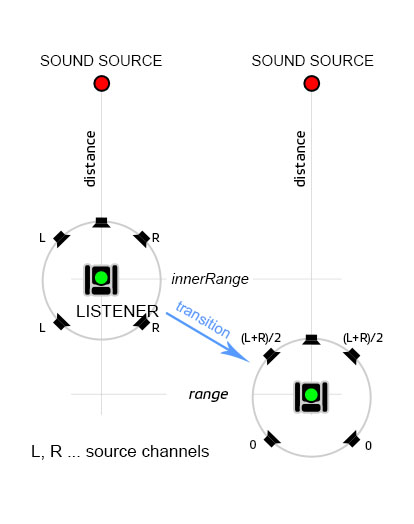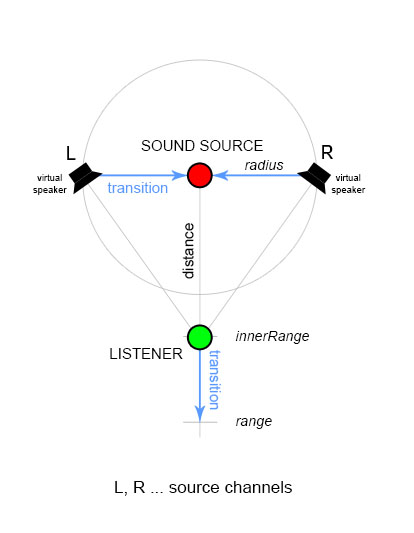Sound: Processing Types – Arma 3
Processing Types
Sound Processing Type in Arma 3 audio engine is method of distribution of source wave file channels to output channels.
All sound processing type classes have to be configured within base class CfgSound3DProcessors.
There are 3 different Sound Processing Types in Arma 3:
- Emitter - spatialized sounds (vehicle engines, animation sounds, weapon shooting without reflections, etc.)
- Panner - stereo sounds which behaves as "local ambients" in closer distance and clearly spatialized sounds in larger distance (weapon shooting reflections, tree leaves rustling, etc.)
- Surround Panner - stereo sounds with custom multichannel panner ("directional ambient ssounds")
Emitter
Sound is played from the location of sound source, so this approach should be used for sounds which need to be clearly spatialized.
- if source wave file is mono, sound is played exactly from the sound source position
- if source wave file is stereo (2 channels), two virtual speakers (emitters) are created on the horizontal circle with the sound source in the center
- virtual speakers (emitters) are always facing towards the listeners direction and they remain in the same distance from the listener (and to each other as well), so the positions of virtual speakers keep with player's movement (rotating around a circle)
Panner
Sound panner was designed for stereo wave files to provide smooth transition between ambient (2D) and positional (3D) sound behavior.
- In closer distances (below innerRange distance) sound behaves as 2D ambient sound, signal is distributed to all channels (left source channel to all left output channels, right source channel to all right output channels, center receives mono downmix with half amplitude).
- In larger distances (above range distance) sound behaves as 3D sound, both source channels are mixed to mono and played from sound source position.
- Between innerRange and range there is an interpolation between two states described above, based on custom transition curve.

|
|
Surround Panner
Ambient panner was designed to be used with stereo sounds (ambients) to simulate their source location by specifying volume values on predefined directions. Generally, it behaves as a multi-channel panner.
- Consider predefined directions as virtual speakers: front-right, front-left, rear-right, rear-left
- For dynamic changes of volume values, use simple expressions with sound controllers
- Using environment-related sound controllers, virtual speakers behaves as evaluation points.
| Parameter | Unit/values | Default | Description |
|---|---|---|---|
| type | type name | "surround_panner" | |
| radius | [m] | 7 |
|
| volumeFrontRight | float (0..n) of [dBFS] | 1 |
|
| volumeFrontLeft | float (0..n) of [dBFS] | 1 |
|
| volumeRearRight | float (0..n) of [dBFS] | 1 |
|
| volumeRearLeft | float (0..n) of [dBFS] | 1 |
|
| volumeAll | float (0..n) of [dBFS] | 1 |
|
| reference | "camera" | "camera" |
|

